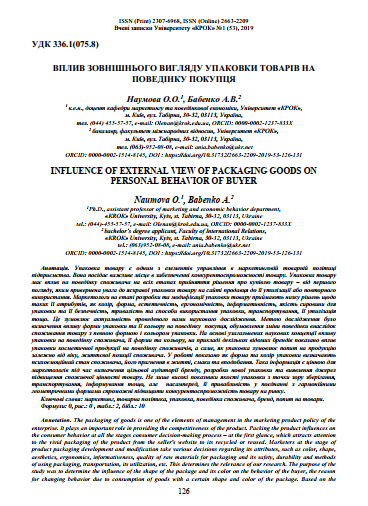INFLUENCE OF EXTERNAL VIEW OF PACKAGING GOODS ON PERSONAL BEHAVIOR OF BUYER
DOI:
https://doi.org/10.31732/2663-2209-2019-53-126-131Keywords:
marketing, product policy, packaging, consumer behavior, brand, demand for goodsAbstract
The packaging of goods is one of the elements of management in the marketing product policy of the enterprise. It plays an important role in providing the competitiveness of the product. Packing the product influences on the consumer behavior at all the stages consumer decision-making process – at the first glance, which attracts attention to the vivid packaging of the product from the seller's website to its recycled or reused. Marketers at the stage of product packaging development and modification take various decisions regarding its attributes, such as color, shape, aesthetics, ergonomics, informativeness, quality of raw materials for packaging and its safety, durability and methods of using packaging, transportation, its utilization, etc. This determines the relevance of our research. The purpose of the study was to determine the influence of the shape of the package and its color on the behavior of the buyer, the reason for changing behavior due to consumption of goods with a certain shape and color of the package. Based on the generalized scientific concepts of packaging influence on consumer behavior, its shape and color, on the example of several well-known brands, the influence of packaging cosmetic products on the behavior of consumers is shown, namely, how packaging determines the demand for products depending on the age, consumer's attitude of life style. The article shows how the shape and color of packaging determine the psycho-emotional state of the consumer, his desire for life, tastes and preferences. Such information is valuable to marketers when defining the target audience of a brand, developing new packaging, and identifying sources for increasing the consumer value of a product. Not only high-quality packaging values in terms of storage, transportation, informing, etc. but above all, its attractiveness combined with harmonious geometric shapes can enhance the competitiveness of the product on the market.
Downloads
References
Giri, P. Pavan Kumar, P. (2015) Fragrance Perception through Perfume Packaging: A Visual Link with Customers.
Sulu A. C., Saerang D. P. E., Massie J. D. D. (2016) “The analysis of consumer purchase intention towards cosmetic products based on product origin”. Jurnal EMBA: Jurnal Riset Ekonomi, Manajemen, Bisnis dan Akuntansi. – 2016. – Т. 4. – №. 2.
Deliya M. (2012) “Consumer behavior towards the new packaging of FMCG products» National Monthly Refereed Journal of Research in Commerce and Management. V. 1. №. 11. 199-211.
Silayoi, P. Speece, M. (2004) “Packaging and purchase decisions: An exploratory study on the impact of involvement level and time pressure”. British food journal”, V. 106. №. 8. p. 607-628.
Ogba, I. E. Johnson, R. (2010) “How packaging affects the product preferences of children and the buyer behaviour of their parents in the food industry”, Young Consumers. V. 11. №. 1. p. 77-89.
Taranenko, V. (2018) Exposed logo, or Psychogeometry. Multimedia publishing house Strelbitsky.
Lusher, M. (1994) Typology of psychological properties of a person.
Moon, P. Spencer, D. E. (1944) “Geometric formulation of classical color harmony” JOSA. V. 34. №. 1. p. 46-59.
Ou L. C., Luo M. R. (2006) “A colour harmony model for two‐colour combinations. Color Research & Application: Endorsed by Inter‐Society Color Council, The Colour Group (Great Britain), Canadian Society for Color, Color Science Association of Japan, Dutch Society for the Study of Color, The Swedish Colour Centre Foundation, Colour Society of Australia, Centre Français de la Couleur” V. 31. №. 3. С. 191-204.
Szabo, F. Bodrogi, P. Schanda, J. (2010) “Experimental modeling of colour harmony. Color Research & Application: Endorsed by Inter‐Society Color Council, The Colour Group (Great Britain), Canadian Society for Color, Color Science Association of Japan, Dutch Society for the Study of Color, The Swedish Colour Centre Foundation, Colour Society of Australia, Centre Français de la Couleur”. V. 35. №. 1. p. 34-49.


